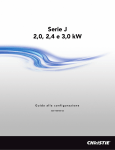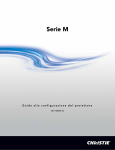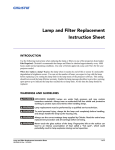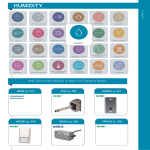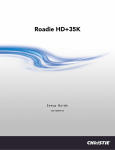Download Christie J series 2.4kW Setup guide
Transcript
J Series 2.0, 2.4, and 3.0 kW Setup Guide 020-100751-01 J Series 2.0, 2.4, and 3.0 kW Setup Guide 020-100751-01 NOTICES COPYRIGHT AND TRADEMARKS © 2011 Christie Digital Systems USA, Inc. All rights reserved. All brand names and product names are trademarks, registered trademarks or trade names of their respective holders. REGULATORY The product has been tested and found to comply with the limits for a Class A digital device, pursuant to Part 15 of the FCC Rules. These limits are designed to provide reasonable protection against harmful interference when the product is operated in a commercial environment. The product generates, uses, and can radiate radio frequency energy and, if not installed and used in accordance with the instruction manual, may cause harmful interference to radio communications. Operation of the product in a residential area is likely to cause harmful interference in which case the user will be required to correct the interference at the expense of the user. This Class A digital apparatus complies with Canadian ICES-003. Cet appareil numérique de la classe A est conforme à la norme NMB-003 du Canada. 㧊 ₆₆⓪ 㠛ⶊ㣿 (A ) 㦒⪲ 㩚㧦䕢㩗䞿❇⪳㦚 䞲 ₆₆㧊㡺┞ 䕦ⰺ㧦 ⡦⓪ ㌂㣿㧦⓪ 㧊㩦㦚 㭒㦮䞮㔲₆ ⧒Ⳇ , Ṗ㩫 㣎㦮 㰖㡃㠦㍲ ㌂㣿䞮⓪ ộ㦚 ⳿㩗㦒⪲ 䞿┞┺ . GENERAL Every effort has been made to ensure accuracy, however in some cases changes in the products or availability could occur which may not be reflected in this document. Christie reserves the right to make changes to specifications at any time without notice. Performance specifications are typical, but may vary depending on conditions beyond the control of Christie such as maintenance of the product in proper working conditions. Performance specifications are based on information available at the time of printing. Christie makes no warranty of any kind with regard to this material, including, but not limited to, implied warranties of fitness for a particular purpose. Christie will not be liable for errors contained herein or for incidental or consequential damages in connection with the performance or use of this material. The product is designed and manufactured with high-quality materials and components that can be recycled and reused. This symbol means that electrical and electronic equipment, at their end-of-life, should be disposed of separately from regular waste. Please dispose of the product appropriately and according to local regulations. In the European Union, there are separate collection systems for used electrical and electronic products. Please help us to conserve the environment we live in! Canadian manufacturing facility is ISO 9001 and 14001 certified. GENERAL WARRANTY STATEMENTS For complete information about the Christie limited warranty, please contact your Christie dealer. In addition to the other limitations that may be specified in the Christie limited warranty, the warranty does not cover: a. Damage occurring during shipment, in either direction. b. Projector lamps (See the separate Christie lamp program policy). c. Damage caused by use of a projector lamp beyond the recommended lamp life, or use of a lamp supplied by a supplier other than Christie. d. Problems caused by combination of the product with non-Christie equipment, such as distribution systems, cameras, video tape recorders, etc., or use of the product with any non-Christie interface device. e. Damage caused by misuse, improper power source, accident, fire, flood, lightning, earthquake or other natural disaster. f. Damage caused by improper installation/alignment, or by product modification, if by other than a Christie authorized repair service provider. g. For LCD projectors, the warranty period specified applies only where the LCD projector is in “normal use.” “Normal use” means the LCD projector is not used more than 8 hours a day, 5 days a week. For any LCD projector where “normal use” is exceeded, warranty coverage under this warranty terminates after 6000 hours of operation. h. Failure due to normal wear and tear. PREVENTATIVE MAINTENANCE Preventative maintenance is an important part of the continued and proper operation of your product. Please see the Maintenance section for specific maintenance items as they relate to your product. Failure to perform maintenance as required, and in accordance with the maintenance schedule specified by Christie, will void the warranty. Table of Contents 1: Introduction 1.1 Purchase Record and Service Contacts .......................................................................................1-1 1.1.1 List of Components..............................................................................................................1-1 1.1.2 Key Features ........................................................................................................................1-2 1.2 Safety Warnings and Guidelines .................................................................................................1-3 1.2.1 General Precautions .............................................................................................................1-3 1.2.2 AC /Power Precautions........................................................................................................1-3 1.2.3 Lamp Precautions ................................................................................................................1-4 2: Installation and Setup 2.1 Projector Quick Setup and Installation ........................................................................................2-1 2.2 Detailed Setup and Installation....................................................................................................2-7 2.2.1 Mounting..............................................................................................................................2-7 2.2.2 Basic Optical Alignment......................................................................................................2-7 2.2.3 Advanced Optical Alignment ..............................................................................................2-8 2.2.4 Powering Down ...................................................................................................................2-10 2.2.5 Projector Communications ................................................................................................2-11 3: Operation 3.1 Using the Remote Keypad or Built-In Keypad ...........................................................................3-1 3.1.1 Remote Keypad Commands ................................................................................................3-4 3.2 Navigating the Menus..................................................................................................................3-8 3.3 Alarms .........................................................................................................................................3-12 4: Maintenance 4.1 Lamp and Filter Replacement......................................................................................................4-1 4.2 Liquid Coolant Module Maintenance..........................................................................................4-5 4.2.1 Liquid Cooler (P/N: 003-100668-XX) ................................................................................4-5 5: Troubleshooting 5.1 Power ...........................................................................................................................................5-1 5.1.1 Projector Does Not Power ON.............................................................................................5-1 5.2 Lamp ............................................................................................................................................5-1 5.2.1 Lamp Does Not Ignite..........................................................................................................5-1 5.2.2 Lamp Suddenly Turns OFF .................................................................................................5-2 5.2.3 Flicker, Shadows Or Dimness .............................................................................................5-2 5.3 LCD .............................................................................................................................................5-2 5.3.1 Blank Screen, No Menu Displaying ....................................................................................5-2 5.4 Remote Keypad ...........................................................................................................................5-2 5.4.1 Remote Keypad Does Not Seem to Work ...........................................................................5-2 5.5 OSD .............................................................................................................................................5-3 5.5.1 The OSD Menu does not display.........................................................................................5-3 5.6 Ethernet........................................................................................................................................5-3 5.6.1 Trouble Establishing Communication with Projector .........................................................5-3 J Series 2.0, 2.4, and 3.0 kW Setup Guide 020-100751-01 Rev. 1 (10-2011) i Table of Contents 5.7 Displays....................................................................................................................................... 5-3 5.7.1 The projector is on but there is no display .......................................................................... 5-3 5.7.2 Severe Motion Artifacts ...................................................................................................... 5-3 5.7.3 Image Appears ‘Squeezed’ or Vertically Stretched into Center of Screen......................... 5-4 5.7.4 The Display is Jittery or Unstable....................................................................................... 5-4 5.7.5 The Display is Faint ............................................................................................................ 5-4 5.7.6 The Upper Portion of the Display is Waving, Tearing or Jittering..................................... 5-4 5.7.7 Portions of the Display are Cut Off or Warped to the Opposite edge ................................ 5-4 5.7.8 Display Appears Compressed (Vertically Stretched) ......................................................... 5-4 5.7.9 Data is Cropped from Edges ............................................................................................... 5-4 5.7.10 Display Quality Appears to Drift from Good to Bad, Bad to Good ................................ 5-4 5.7.11 Display has Suddenly Frozen............................................................................................ 5-5 5.7.12 Colors in the Display are Inaccurate ................................................................................. 5-5 5.7.13 Display is Not Rectangular ............................................................................................... 5-5 5.7.14 Display is “Noisy” ............................................................................................................ 5-5 5.8 Web Interface.............................................................................................................................. 5-6 5.8.1 After upgrading the projector software, the Web pages do not display correctly............... 5-6 5.8.2 A backup or Interrogator file cannot be saved .................................................................... 5-6 7: Specifications 7.1 Feature Set .................................................................................................................................. 7-1 7.1.1 Air Filters (Optional) .......................................................................................................... 7-1 7.1.2 Lamps.................................................................................................................................. 7-1 7.2 Input (Source Signal) Compatibility .......................................................................................... 7-1 7.2.1 Analog (Only) Input............................................................................................................ 7-1 7.3 Control Signal Compatibility ..................................................................................................... 7-1 7.3.1 Projector Control................................................................................................................. 7-1 7.4 Power Requirements ................................................................................................................... 7-2 7.4.1 Lamp Specification ............................................................................................................. 7-2 7.5 Accessories and Service Components ........................................................................................ 7-3 7.6 Regulatory................................................................................................................................... 7-4 7.6.1 Electro-Magnetic Compatibility ......................................................................................... 7-4 7.6.2 Environmental ..................................................................................................................... 7-4 7.6.3 Marking ............................................................................................................................... 7-5 A: GPIO A.1 GPIO Port................................................................................................................................... A-1 ii J Series 2.0, 2.4, and 3.0 kW Setup Guide 020-100751-01 Rev. 1 (10-2011) 1 Introduction Every effort has been made to ensure the information in this document is accurate and reliable; however, due to constant research the information in this document is subject to change without notice. 1.1 Purchase Record and Service Contacts Whether the projector is under warranty or the warranty has expired, Christie highly trained and extensive factory and dealer service network is always available to quickly diagnose and correct projector malfunctions. Complete service manuals and updates are available for all projectors. Should a problem be encountered with any part of the projector, contact your dealer. In most cases, servicing is performed on site. If you have purchased the projector, fill out the information below and keep with your records. Table 1.1 Dealer: Dealer or Christie Sales/Service Contact Phone Number: Projector Serial Number*: Purchase Date: Installation Date: * The serial number can be found on the license label located on the back of the projector. Table 1.2 Ethernet Settings Default Gateway: DNS Server: Projector DLP Address: Projector Mgmt IP Address: Subnet Mask: 1.1.1 List of Components Ensure the following components were received with the projector: Projector with Built-In Keypad (LCD status display) IR remote keypad (includes two, 1.5V AA batteries and an XLR to mini-stereo cable conversion to wired) Line cord Lens Mount Security Screw (M6x10mm long, Qty. 2) Lens Mount Security Screw Driver (5mm Hex, Qty. 1) Warranty Card Web Registration Form J Series 2.0, 2.4, and 3.0kW Setup Guide 020-100751-01 Rev. 1 (10-2011) 1-1 Section 1: Introduction 1.1.2 Key Features • • • • • • • • • • • • • • • • Up to 22,000 lumens HD (1080p), SXGA+ or WUXGA resolution Xenon lamp with 1900W, 2400W or 3000W options 10-bit image processor electronics with modular design Active fan control for minimum noise level User interchangeable projection lenses with no-tool mounting Picture In Picture (PIP) LiteLOC for constant brightness maintenance Intelligent Lens System (ILS) Motorized lens mount for all models Auto-setup feature Integrated ChristieNET Networking ability through RS-232 and RS-422 connectors Status LED display on built-in keypad for easy projector status monitoring Control with remote keypad, wired remote, or built-in keypad Four input slots for Optional Input Modules Refer to 7 Specifications for a complete list of technical specifications. Table 1.3 J Series Projectors Model Name 1-2 Part Number Roadster S+14K-J 132-010113-XX Roadster HD14K-J 132-011114-XX Roadster S+18K-J 132-013116-XX Roadster HD16K-J 132-014117-XX Roadster S+22K-J 132-016119-XX Roadster HD20K-J 132-017110-XX Roadster WU20K-J 132-018111-XX J Series 2.0, 2.4, and 3.0kW Setup Guide 020-100751-01 Rev. 1 (10-2011) Section 1: Introduction 1.2 Safety Warnings and Guidelines 1.2.1 General Precautions HIGH BRIGHTNESS. Never look directly into the projector lens. The extreme high brightness can cause permanent eye damage. Always power down the projector and disconnect all power sources before servicing or cleaning. FIRE HAZARD. Keep hands, clothes and all combustible material away from the concentrated light beam of the projector. Position all cables where they cannot contact hot surfaces or be pulled or tripped over. WARNING All installation and maintenance procedures must be performed by a Christie accredited service technician. WARNING Projector must be operated in an environment that meets operating specifications, as listed in 7 Specifications. 1.2.2 AC /Power Precautions WARNING Use only the AC power cord supplied. Do not attempt operation if the AC supply and cord are not within the specified voltage and power range. Refer to the license label on the back of the projector or 7 Specifications for rated voltage and power. WARNING The projector is equipped with a 3-wire plug with a grounding pin. This is a safety feature. If you are unable to insert the plug into the outlet, contact an electrician to have the outlet replaced. NEVER defeat the safety purpose of the grounding-type plug. WARNING Do not allow anything to rest on the power cord. Locate the power cord where persons walking on it or objects rolling over it cannot damage the cord. J Series 2.0, 2.4, and 3.0kW Setup Guide 020-100751-01 Rev. 1 (10-2011) 1-3 Section 1: Introduction 1.2.3 Lamp Precautions WARNING 1-4 Never attempt to access the lamp while the lamp is ON. After turning the lamp OFF, it is crucial that you wait at least 5 minutes before handling the lamp. This provides sufficient time for the lamp cooling fans to properly cool the lamp. For all other precautions critical for safe removal and replacement of the lamp, refer to 4.1. J Series 2.0, 2.4, and 3.0kW Setup Guide 020-100751-01 Rev. 1 (10-2011) 2 Installation and Setup This section explains how to install, connect and optimize the projector for delivery of superior image quality. Illustrations are graphical representations only and are provided to enhance the understanding of the written material. 2.1 Projector Quick Setup and Installation The following instructions are for those preferring a quick setup. Refer to the remaining subsections for detailed setup instructions. Always power down the projector and disconnect all power sources before servicing or cleaning. Refer to Safety Warnings and Guidelines in 4 Maintenance. STEP 1 - Installing a Projection Lens The projection lens, shipped separately from the projector, must be installed prior to setting up the projector. Remove the lens plug from the lens opening in the projector before installing the lens. Retain the lens plug for projector transportation to protect the optical components from dust and debris. IMPORTANT! The lens seals the projector, preventing contaminants from entering the interior of the projector. Never operate a projector without a lens. LENS INSTALLATION IMPORTANT! Remove the rear lens cap from the lens. Keep the front lens cap on the lens to protect it during installation. 1. Rotate the lens clamp clockwise to the OPEN position, see Figure 2-1. FIGURE 2-1 J Series 2.0, 2.4, and 3.0 kW Setup Guide 020-100751-01 Rev. 1 (10-2011) 2-1 Section 2: Installation and Setup 2. Align the lens interface plate with the lens mount. Align the lens electrical connector with the mating connector on the lens mount. Fully insert the assembly straight into the lens mount opening without turning. Press using your hand as shown in Figure 2-2. NOTE: When installing the lens, ensure that the lens is not inserted at an angle, as this can cause damage. FIGURE 2-2 3. Remove the front lens cap. 4. While holding the lens flat against the lens mount, rotate the lens clamp clockwise to lock the lens assembly in place. See Figure 2-3. FIGURE 2-3 5. For added stability such as motion applications, fasten the security screws provided with the lens mount. Refer to Figure 2-4. 2-2 J Series 2.0, 2.4, and 3.0 kW Setup Guide 020-100751-01 Rev. 1 (10-2011) Section 2: Installation and Setup FIGURE 2-4 6. Use a 5mm hex screwdriver to fasten the red security screws provided with the lens mount (Figure 2-4), or hand tighten the lens retaining screws attached to the lens. NOTES: 1) Recommended for heaviest lenses such as 0.73:1 and 1.2:1. 2) The red security screws MUST be installed when hoisting the projector overhead, or installing the projector in an overhead position. Use of the lens red security screws or the lens retaining screws is required if the projector is hoisted or installed in an overhead position. STEP 2 - Positioning the Projector 2 people are required to safely lift and install the projector. Place the projector on a sturdy, level surface and position it so that it is perpendicular to the screen at a suitable distance. With the projector positioned perpendicular to the screen, the image will appear rectangular instead of keystoned. To level the projector, adjust the height of the feet. For more detailed instructions on positioning the projector refer to 2.2.1 later in this section. STEP 3 - Connecting a Source Located at the back of the projector is the input panel where all source connections are made. Each input is clearly labeled for easy identification. Depending on the type of option card installed, connect your source using the appropriate cable(s), as follows: • Analog Input Card, connect 3-, 4-, or 5-wire RGB source to Red/Pr, Green/Y, Blue/Pb, H/C and V using 3, 4 or 5 BNC connectors as required. • Dual 3G/SD/HD - SDI Input Card, connect SDI (Serial Digital Interface) cable to one of the two inputs, 1IN or 2-IN. Both standard-definition (SD) and high-definition (HD) 3GHz signals are accepted and automatically recognized on either input. • Dual Link DVI Input Card, connect a single or dual link DVI video signal to the DVI-I connector, an analog video signal to the DVI-I connector or an analog video signal to the VGA connector. The DVI signal may contain HDCP (High-Bandwidth Digital Content Protection). • Twin HDMI Input Card, connect HDMI (High-Definition Multimedia Interface) cable to one of the two inputs, 1-IN or 2-IN. J Series 2.0, 2.4, and 3.0 kW Setup Guide 020-100751-01 Rev. 1 (10-2011) 2-3 Section 2: Installation and Setup • Video Decoder Input Card, depending on the source you can apply the following; • Composite video source to 1-CVBS, using a BNC Cable NOTE: Same signal can be used on 4, 5 or 6 when input is selected as CVBS. • Component input grouping is selected in the projector menu. • A component signal on Inputs 4(Pr), 5(Y), 6(Pb) using BNC Connectors. NOTE: Grouped as a component input, YPbPr. • S-Video to one of the two, 2-SVID or 3-SVID using S-Video cable. • S-Video using two BNC cables, with Luma (Y) connected to 4 (Sy) and Chroma (C) connected to 6 (Sc). NOTE: Must be grouped as 1 S-Video + 1 CVBS. • DMX512 Interface Card, has two 5pin XLR connectors - 1 (input) male and 1 (output) female. If there is active communications on the DMX512 Interface card the power LED will blink between low intensity and high intensity. STEP 4 - Connecting the Line Cord IMPORTANT! Use the line cord provided with the projector. NOTE: Voltage and current requirements are listed on the license label, located at the back of the projector. To prevent the line cord from inadvertent disconnection, perform one of the following steps: For 1900W and 2400W Models 1. Connect the line cord of the projector to the AC receptacle at the AC inlet of the projector, then push the wire clip over the plug to retain it, as shown in Figure 2-5. FIGURE 2-5 2-4 J Series 2.0, 2.4, and 3.0 kW Setup Guide 020-100751-01 Rev. 1 (10-2011) Section 2: Installation and Setup For 3000W Model 1. Remove the locking pin from the bracket surrounding the AC receptacle at the AC inlet of the projector by pressing down on the button on the end of the locking pin, and then pull upwards on the pin to remove it, as shown in Figure 2-6. FIGURE 2-6 2. Open the cap on the AC plug and line up the slot on the plug with the pin on the receptacle. See Figure 2-7. FIGURE 2-7 J Series 2.0, 2.4, and 3.0 kW Setup Guide 020-100751-01 Rev. 1 (10-2011) 2-5 Section 2: Installation and Setup 3. Insert the plug fully on to the receptacle. When fully inserted, the cap on the AC plug will rest against the side of the projector (Figure 2-8). 4. Reinsert the locking pin into the bracket surrounding the AC receptacle by pressing down on the button on the end of the locking pin and insert the pin into the bracket, as shown in Figure 2-8. Do not attempt operation if the AC supply and cord is not within the specified ratings. On power down, wait 5 minutes for the fans to turn OFF before unplugging the projector. Always switch off the projector before unplugging the AC line cord. FIGURE 2-8 STEP 5 - Power up After the AC Power has been switched on, the LCD display above the keypad indicates “Please wait” and the 4 LED status indicators at the rear of the projector will be solid amber. The projector has reached standby and is ready for use when: • The LCD displays “Standby mode” • The Status LED is solid amber • The Lamp LED is off To turn on the projector, do one of the following: • Press and hold the power button on either the built-in keypad or the remote control • Press the power button twice (quickly) on either the built-in keypad or the remote control Thereafter; the lamp and fans will power on and a green LED will start scrolling back and forth indicating that the projector is in warm up mode. The projector is on and ready to display video when the lamp LED and the status LED are both solid green. NOTE: See 3 Operation for a full description of the status indicators. NOTE: If the projector has a stepper motor lens mount installed and the inserted lens has never been calibrated, there will be a short period where the projector calibrates all of the lens motors (zoom, focus, horizontal, and vertical) by moving them through their full range of motion. 2-6 J Series 2.0, 2.4, and 3.0 kW Setup Guide 020-100751-01 Rev. 1 (10-2011) Section 2: Installation and Setup STEP 6 - Selecting a Source Press one of the input keys on the remote or built-in keypad to select and display the image for the source you connected in Step 3. STEP 7- Adjusting Image Adjust the image settings, such as Brightness, Contrast, Gamma, Focus, Zoom etc. using the direct keys on the remote or built in keypad. NOTE: Refer to 3 Operation for more details. 2.2 Detailed Setup and Installation Always power down the projector and disconnect all power sources before servicing or cleaning. Refer to Safety Warnings and Guidelines in 4 Maintenance. 2.2.1 Mounting There are several methods for mounting the projector. Depending on your chosen installation, one method may be more suitable than another. In typical front and rear screen installations the projector can be mounted to a secure and level surface, such as a table or cart. Carts are useful when the projector has to be moved during a presentation or from site to site. It is recommended you lock the wheels on a cart, when the cart is in position, to prevent someone from accidentally moving it during a presentation. Ceiling Mount The projector can be inverted and suspended from the ceiling using a specially designed ceiling mount 104104001XX. This mounting is recommended for fixed installations and for those that want the projector out of plain view or have limited amount of space for the projector and audience. For more information, contact your dealer. Use only the Christie approved ceiling mount kit designed for your projector. Refer to the installation instructions and safety guidelines provided in the kit. 2.2.2 Basic Optical Alignment Only perform image alignment once the projector is fully assembled and powered up in its final location. Basic image alignment ensures the image reflected from the DMDs is parallel to and well-centered with the lens and screen. This initial optical alignment is the foundation for optimizing images on the screen and must be completed before final boresight adjustments. Before beginning ensure the projector is properly positioned relative to the screen. Basic Optical Alignment Procedure 1. Display a test pattern: Appropriate for analyzing image focus and geometry, such as the “framing” test pattern showing the cross-hair centered across the image. Press the TEST key on the remote keypad or use the built-in keypad and press the soft key that displays Test on the LCD display. 2. Course focus: Do a quick preliminary focus and (if available) zoom adjustment with the primary lens. Do not worry about consistency across the image at this point, just center focus. It is good practice to have zoom adjustment color and focus adjustment color in the center of its range. J Series 2.0, 2.4, and 3.0 kW Setup Guide 020-100751-01 Rev. 1 (10-2011) 2-7 Section 2: Installation and Setup 3. Center the image in the lens: Holding a piece of paper at the lens surface, adjust offsets as necessary until the image is centered within the lens perimeter. A full white field works best for this. 4. If necessary, center the image on the screen: If the projector is mounted off center to the screen axis, then offset the lens as much as required. Aim the projector over slightly towards the center of the screen, but use caution when doing so, as too much tilt will cause excessive keystone distortion. Lens offset will not. 5. Re-check side-to-side leveling: With the framing pattern on screen, double-check projector leveling so the top edge of the image is parallel to the top edge of the screen. 6. Throw Distance: Ensure the projector is positioned in the throw distance range for the particular lens. Folded Optics In rear screen applications where space behind the projector is limited, a mirror may be used to fold the optical path, see Figure 2-9. The position of the projector and mirror must be accurately set - if considering this type of installation call your dealer for assistance. FIGURE 2-9 2.2.3 Advanced Optical Alignment Boresight Alignment Procedure 1. Display the Boresight Test Pattern by pressing the TEST key on the remote keypad or use the built-in keypad and press the soft key that displays Test on the LCD display, then UP ARROW KEY to cycle to Boresight, then Enter, see Figure 2-10 . FIGURE 2-10 2-8 J Series 2.0, 2.4, and 3.0 kW Setup Guide 020-100751-01 Rev. 1 (10-2011) Section 2: Installation and Setup 2. Focus the image on cross-hair pattern I. Evaluate the focus on cross-hair image II and III. If all 3 images are in focus, no further action is required. If boresight is required see step 3. 3. If boresight is required, refer to Figure 2-11 to understand how the adjustment screws on the lens mount affect the corresponding cross-hairs on the test pattern. NOTE: The cap screw, (Figure 2-12) may be under a plastic cap, remove and retain before adjusting. 4. Use a 5mm Allen™ key to loosen the 3 locking setscrews on the lens mount, see Figure 2-12, below. NOTE: The setscrews must be backed out several turns, so that they do not contact the inner lens mount plate. FIGURE 2-11 FIGURE 2-12 5. Fine tune the focus of cross-hair pattern I by adjusting the appropriate cap screw, see Figure 2-12. Adjust until the cross-hair image is in focus with minimal flare. 6. Adjust cross-hair pattern II, by adjusting the appropriate cap screw, see Figure 2-12. Adjust until the crosshair image is in focus with minimal flare. 7. Adjust cross-hair pattern III, by adjusting the appropriate cap screw, see Figure 2-12. Adjust until the cross-hair image is in focus with minimal flare. 8. Repeat step 5, 6, and 7 as required until all 3 cross-hair patterns are in equal sharp focus. If the boresight is acceptable, see step 11. If the boresight does not appear to be converging to an acceptable level of image quality or if the lens will not focus over the correct range of throw distances, then the boresight requires coarse adjustment, see step 9. 9. The original factory boresight can be recovered approximately by positioning the 3 setscrews, see Figure 2-12. Position the setscrews flush with the front face of the lens mount plate and in contact with the inner lens mount plate. Refer to Figure 2-13 . This may require adjusting both setscrews and cap screws. 10. If further action is required. Repeat #2. J Series 2.0, 2.4, and 3.0 kW Setup Guide 020-100751-01 Rev. 1 (10-2011) 2-9 Section 2: Installation and Setup 11. Lock the setscrews, and re-check the boresight quality. Tighten the setscrew enough to ensure they will not shift. FIGURE 2-13 2.2.4 Powering Down The projector can be powered down by using one of the following methods: Remote Keypad/Built-In Keypad • Press and hold POWER OR • Press POWER twice OR • Press POWER once, then immediately press the DOWN key. NOTE: For Step 2 and 3, if the FIGURE 2-14 POWERING DOWN/WEB USER INTERFACE second key is not pressed immediately, a confirmation window will appear. The second key press must be pressed within 1 second of the window appearing. NOTE: After powering down, the Status LEDs cycle and the LCD displays the message “Cooling Down”, until cool down is complete. Web User Interface (UI) 1. From the Main Tab, Select Power>OFF. NOTE: A window will display for confirmation on powering down, see Figure 2-14. 2. Select Yes. 2-10 J Series 2.0, 2.4, and 3.0 kW Setup Guide 020-100751-01 Rev. 1 (10-2011) Section 2: Installation and Setup 2.2.5 Projector Communications Status LEDs Looking from the back of the projector, the LEDs represent, from left to right; Lamp, Comm, Status, and Shutter. The LEDs will display the colors as shown below: Status LEDs Lamp # 1 LED State Off - lamp off Yellow- Lamp time has expired and lamp should be replaced Green - Lamp is on and operating correctly Flashing Red - Lamp has malfunctioned Flashing Yellow - Lamp door is open Comm 2 Flashing Green - Projector communication in progress Status 3 Off - AC power is off Yellow- AC is present but projector is in standby Green -Projector is powered up and operating normally Flashing Red - Error has occurred. Details are displayed on the status display Shutter 4 Green - Shutter is open Yellow - Shutter is closed NOTE: A condition occurs on the first power on after a software upgrade, and is indicated by all the following: • • • • The Status LEDs are cycling green The LCD displays the warning "Image Processor Upgrading" The LED on the Image Processor card flashes green The Web page shows a warning that the Image processor card is upgrading. When this occurs, the projector should not be AC power cycled and the Image Processor card should not be removed. J Series 2.0, 2.4, and 3.0 kW Setup Guide 020-100751-01 Rev. 1 (10-2011) 2-11 3 Operation This section describes the controls and switches used for basic projector operation once it is properly installed, aligned and configured by a Christie accredited service technician. Refer to Safety Warnings and Guidelines in 4 . 3.1 Using the Remote Keypad or Built-In Keypad The projector is typically controlled using one of the following keypads: • Remote Keypad for wired or wireless control up to 25 feet (8m) away (includes cable for use as a wired remote). The remote keypad controls the projector by way of wireless communications from a batterypowered infrared (IR) transmitter. Use the remote keypad the same way you would use a remote keypad supplied with a TV or VCR. When pressing a function key, direct the keypad toward the front or rear IR sensor. One of the two IR sensors on the projector will detect the signal and relay the commands for internal processing. A laser pointer is built into the remote keypad. See Figure 3-1 . • Built-in Keypad located at the rear of the projector. See Figure 3-2 . While each of the keypads provides complete control of the projector, they differ slightly in their arrangement of keys and in what functions can be accessed directly with a key press rather than requiring use of the menu system. You may find one keypad more convenient than another for your specific installation and application. Guide to Keypads Keep these guidelines (common to both keypads) in mind: • Press keys one-at-a-time; there are no simultaneous key combinations required. NOTE: Use POWER, SHUTTER, and OSD functions by doing one of the following: “press-and-hold” (2 seconds) or press twice quickly, followed by pressing either the UP ARROW KEY to switch on or the DOWN ARROW KEY to switch off once. See Figure 3-1 . • Arrow keys are held down for continuous adjustment/movement in the related key direction. NOTE: In serial networks, pause briefly between adjustments to make sure that more distant projectors can “keep up” with the commands. If you press a key while the projector is still responding to the previous action, such as during power-up, the second key press may not take effect. Refer to Figure 3-1 for the description of those keys provided for the remote keypad. J Series 2.0, 2.4, and 3.0 kW Setup Guide 020-100751-01 Rev. 1 (10-2011) 3-1 Section 3: Operation Remote Keypad FIGURE 3-1 REMOTE KEYPAD 3-2 J Series 2.0, 2.4, and 3.0 kW Setup Guide 020-100751-01 Rev. 1 (10-2011) Section 3: Operation Wired Remote You can convert the remote keypad into a wired remote keypad using the cable provided with the projector. Connect one end into the remote and the other to the XLR connector on the input panel labeled as wired keypad. The wired remote is recommended when: • The built-in keypad is inaccessible • The lighting conditions are unsuitable for proper IR transmission NOTE: Leave the batteries in the wired remote for the laser pointer key to work. Built-in Keypad FIGURE 3-2 The built-in keypad has a LCD status display window which displays all states of the keypad controls. The LCD displays status information when the projector is powering up “Warm up: Lamp is warming up” and when the projector is cooling down “Cool down: Lamp is cooling down.” The display shows the state of the keys, menu structure, and menu items. Overview of LED and Key States The LED color of the keys indicates that the key is in one of these states: • Amber, a functionality is available that will affect the displayed image of the projector • Blue, a functionality is available that is relevant to the built-in LCD only and will not affect the displayed image from the projector • Off, the key is disabled in the current context J Series 2.0, 2.4, and 3.0 kW Setup Guide 020-100751-01 Rev. 1 (10-2011) 3-3 Section 3: Operation • Power Key, used to switch from Standby mode to ON, and from ON to Standby mode; LED always remains Amber • Help Key, only available in the On Screen Display (OSD) context; LED is Amber when the menu is being displayed on the projected image display; when no menu is being displayed, the Help key is still enabled if the OSD is enabled. It is only disabled when the entire OSD is set to OFF. • Auto Key, enabled state when the power is ON, and there are no test patterns on the screen. If the power is OFF or a test pattern displays, the Auto key is disabled. • Exit Key, is determined in the specific context of the screen being displayed. • Input Key, enabled when the power is ON. Disabled if the power is OFF. • Lens Key, enabled when the power is ON. Disabled if the power is OFF. • Shutter Key, enabled when the power is ON. Disabled if the power is OFF. • Menu Key, always remains in the enabled state when the power is ON. If the power is off the Menu key is disabled. • Soft Key, used to select an action indicated by text above the key on the LCD. If no text is shown, the associated key is disabled. • Convenience Light Key, toggles the input panel light ON or OFF. 3.1.1 Remote Keypad Commands Specific keypad commands are explained, see Figure 3-1 : Power ON/OFF Press and hold POWER for two seconds or press twice quickly to turn the projector ON or OFF. Or press and release POWER followed immediately by UP ARROW KEY (ON) or DOWN ARROW KEY (OFF) to guarantee the correct action (useful if you are unsure of the present state). NOTES: 1) After powering down, the lamp cooling fan remains on for approximately five minutes to cool the lamp. 2) Avoid turning the projector back on until it has been off for a few minutes. Hot re-strikes of the lamp will reduce lamp life. Test Steps forward through all internal test patterns. After stepping past the last test pattern, you will return to current input. Press TEST and then cycle by using the LEFT ARROW KEY and RIGHT ARROW KEY arrow keys, to cycle in either direction through the test patterns. Press EXIT to return to the current input. Auto Initiates an automated process in which the projector optimizes critical display parameters such as size, position, pixel tracking, etc., for the current source. An auto setup can save time in perfecting a display and you can modify the adjustments as desired. NOTE: You must have an unlocked channel present to use Auto Setup. The best auto setup will be obtained under the following conditions: • Input levels, it is best to have an image with saturated (very bright) colors. • Phase, high contrast edges are needed. To determine active window size: • Video images should have whites and blacks in the image. • Wide range video images should have content (including white) that extends to all edges of the image. 3-4 J Series 2.0, 2.4, and 3.0 kW Setup Guide 020-100751-01 Rev. 1 (10-2011) Section 3: Operation Channel Select a specific source setup (channel) defined and stored in projector memory. Once you enter a two-digit channel number (or, if there is a list displayed, highlight it and press ENTER), the display will automatically change and update according to the numerous setup parameters defined for that channel. NOTE: A new channel is automatically created if you adjust an image from a new source. NOTE: CHANNEL key behavior during a presentation depends on whether or not the Display Channel List option is enabled in the Menu Preferences menu. You can select to use a scrollable list of channels when you press CHANNEL, or you may prefer to enter the desired channel number “blind”, i.e., without on-screen feedback. Slot 1, 2, 3, 4 Press to display the next active input on the card in the slot. Input Displays all inputs in all slots, both active and inactive. Scroll through the list to select an input for the main image. Press Input again to show the list and select the picture-in-picture (PIP) image. PIP Turns PIP ON or OFF. Swap Swaps the main and PIP images. Contrast Changes the level of peak white in your images. Use LEFT/RIGHT ARROW KEY until you reach the desired level of contrast—for best results, start low and increase so that whites remain bright but are not distorted or tinted and that light areas do not become fully white (i.e., “crushed”). Conversely, low contrast causes dim images. Bright Increases or decreases the black level in the image. Use LEFT/RIGHT ARROW KEY until you reach the desired level of brightness. For best results, start high and decrease so that dark areas do not become fully black (i.e., “crushed”). Conversely, overly high brightness changes black to dark grey, causing washed-out images. Gamma Determines how grey shades are displayed between minimum input (black) and maximum input (white) for a given amount of signal. The proper setting helps maintain optimized blacks and whites while ensuring a smooth transition for the “in-between” values utilized in greys. Unlike brightness and contrast controls, the overall tone of an image can be lightened or darkened without changing the two extremes and your images will be more vibrant yet with good detail in dark areas when using the Gamma control. The nominal setting for Gamma Correction of 0 is correct for most signals and conditions. If excess ambient light washes out the image and it becomes difficult or impossible to see details in dark areas, increase the gamma correction setting to compensate. J Series 2.0, 2.4, and 3.0 kW Setup Guide 020-100751-01 Rev. 1 (10-2011) 3-5 Section 3: Operation Number Keys Press 1 to 9 to enter a value in a text box or to select a menu item. 10+ Press 0 before pressing another number to enter a number greater than 9, e.g. press 0 then 2 to enter the number 12 as a menu selection. NOTE: When entering numbers in a text field, this button acts as 0. Help Press HELP to display context-sensitive help. Press HELP again to toggle the help window OFF. Menu Press MENU to enter or exit the projector menu system. OSD (On-screen display) Press OSD then the DOWN ARROW to hide the projector menu system during use. To see the menus again, do one of the following: • Press and hold OSD for two seconds. • Press and release OSD followed immediately by UP ARROW. • Press OSD, OSD. Invisible menus are fully functional, enabling “hidden” access to numbered features and image adjustments by entering the corresponding sequence of key presses on the keypad. NOTE: With OSD “on”, you can still hide error messages and slide bars by disabling these options in the Menu Preferences menu. Shutter Press and hold SHUTTER for two seconds to toggle the internal mechanical shutter blade closed or open with a single keystroke. Or press and release SHUTTER followed immediately by UP ARROW KEY (closed) or DOWN ARROW KEY (open) to guarantee the correct state (useful if you are unsure of the present state). Alternatively, press SHUTTER, SHUTTER to toggle from the present on/off state. A closed shutter blanks the display (turns it to black). Close the shutter to block the displayed image while maintaining access to projector functions. Opening the shutter restores the image. NOTES: 1) The LCD display shows the current state of the shutter. 2) The shutter is open upon power-up. Function Key IF WITHIN A NUMERIC FIELD IN A MENU: Use FUNC to enter a negative number. IF WITHIN A TEXT FIELD: Press FUNC followed by the UP ARROW KEY or DOWN ARROW KEY to convert between capital and lower case letters. Press FUNC followed by the LEFT ARROW KEY or RIGHT ARROW KEY to insert or delete a character. Press FUNC followed by ENTER to delete all characters. 3-6 J Series 2.0, 2.4, and 3.0 kW Setup Guide 020-100751-01 Rev. 1 (10-2011) Section 3: Operation IF WITHIN A PRESENTATION: Press FUNC followed by two numeric numbers to enable a specific color or colors in the display (see right). For example, will display only red, and will display green data. Eliminating one or more colors can help with certain diagnostics and setups, such as when accurately overlaying one image on top of another from stacked projectors. NOTE: Color enabling can also be implemented from numerous locations within the menu system. Press FUNC followed by HELP to disable Keystone, Edge Blending and Brightness Uniformity settings. This will disable the features without changing the settings associated with them. FIGURE 3-3 Projector Press PROJ to access a specific projector within a group of projectors or to confirm if the local projector is listening. The number in the “Enter Number” window indicates which projector is currently listening to commands, and will match the projector number that has been defined in the Menu Preferences menu. The PROJ check box (read-only) shows whether or not the projector physically connected to a keypad is listening to commands from that keypad. A checkmark means that connected projector is listening; if there is no checkmark, you are communicating with a different projector. To control a specific projector with the keypad, press PROJ and then enter the three-digit number assigned to the projector you want to use. If you switch to a projector other than the one you are currently using, the checkmark will disappear. To broadcast to multiple projectors, press PROJ and then PROJ again without entering a projector number. Keypad commands will then effect all projectors present. NOTE: There is no method of controlling a group of projectors within the same wired configuration using the wired keypad exclusively, since there is only one wired protocol available. NOTE: The address for the projector can be set in the Configuration Menu> Communications Submenu. Enter Press ENTER to select a highlighted item, to toggle a check box, or to accept a parameter adjustment and return to the previous menu or image. Exit Press EXIT to return to the previous level, such as the previous menu. NOTE: EXIT does not save changes within text editing boxes (including number editing of a slide bar value) or within pull-down lists. It acts as a “cancel” in these cases. Arrow Keys Use the LEFT/RIGHT ARROW KEY to change a slide bar value or to select a different option within a pull-down list without having to first scroll through options or navigate within a menu, pull-down list or text box. J Series 2.0, 2.4, and 3.0 kW Setup Guide 020-100751-01 Rev. 1 (10-2011) 3-7 Section 3: Operation Lens H and Lens V When adjusting the image for focus, zoom or horizontal and vertical positioning, use the specific arrow keys (LEFT/RIGHT ARROW KEY or UP/DOWN ARROW KEY) related to each function. A small window will appear to indicate the type of adjustment taking place. For example, • • • • Use the FOCUS and the LEFT ARROW or RIGHT ARROW KEY to improve image clarity as desired. Use the ZOOM and the LEFT ARROW or RIGHT ARROW KEY to achieve a desired image size. Use the LENS H and the LEFT ARROW or RIGHT ARROW KEY to position the image horizontally. Use the LENS V and the UP ARROW or DOWN ARROW KEY to position the image vertically. Press EXIT to return to a presentation level. NOTE: Use the LENS key (built-in keypad) with the general UP/ DOWN ARROW KEY to get the same effect as if using the arrow keys related to “Lens V” or “Lens H” on the Remote Keypad. All 4 lens settings can be adjusted by using the soft keys. Laser Press LASER to activate the laser pointer on the remote. Point the remote at the screen to highlight an area of your presentation. NOTE: Leave batteries in the wired remote keypad for the LASER key to work. 3.2 Navigating the Menus Main Menu Most of the projector controls are accessed from within the projector menu system. There are several groups of related functions, with each group selectable from the Main menu as shown at right. Press MENU at any time to display this Main menu. On the remote keypad, enter the number corresponding to the function menu you wish to access, such as 2 for the Image Settings menu. Or use the UP/DOWN ARROW KEY on any keypad to highlight the desired option, then press ENTER. The corresponding function menu or pull-down list of further options will appear. With a function menu displayed, enter a menu option number for any numbered option, or use the UP/DOWN ARROW KEY to highlight the desired option and then press ENTER. Long menus have a scroll bar on the right— use the arrow keys to access the remainder of the menu. Locked items or items that do not pertain to the current action or condition appear dimmed and cannot be selected. When finished with a function menu: • Press EXIT to return to the previous screen. OR • Press MENU to leave the menu system and return to the presentation. NOTES: 1) If there is no signal present, all source-dependent adjustments are disabled. 2) After 15 minutes of inactivity, the projector leaves the menu system and returns to the presentation. 3) The Status menu is readonly. 3-8 J Series 2.0, 2.4, and 3.0 kW Setup Guide 020-100751-01 Rev. 1 (10-2011) Section 3: Operation On-line Help Press HELP to display summary information about the current menu or highlighted option. Press HELP again to exit. The Global Icon Menu options that include this icon apply universally. Menu options without this icon apply to the selected channel only, or are unsaved diagnostic settings. Using Slide bars and Other Controls Most of the function menus allow you to change settings by using slide bars, check boxes, and pull-down lists. Navigating options: • Enter the menu option number corresponding to the setting you wish to change (for example, press MENU 1 3 to select “Vertical Stretch” in the Size and Position menu). • Move the highlight to the option desired and press ENTER. • Move the highlight to the option desired and press LEFT/RIGHT ARROW KEY to adjust immediately. • You can bypass the menus entirely and use a single key to immediately access an adjustment during your presentation (applies only to options having their own key, such as Contrast, Brightness, Gamma, etc.). • For “blind” access, hide the entire menu system (see OSD key, above) and access using the proper sequence of key presses. Slide bars in menus – The current value for a given parameter, such as size or vertical stretch, appears to the left of its slide bar icon (adjustment window). This number often expresses a percentage, or it may have units associated with it (such as pixels), depending on the specific option. Press LEFT/RIGHT ARROW KEY to gradually adjust the setting up or down—both the number and the length of the bar change accordingly. Hold for continuous adjustment. Or press ENTER to activate a slide bar text box for specific number entry via the keypad and then press ENTER to save (or press EXIT to cancel). J Series 2.0, 2.4, and 3.0 kW Setup Guide 020-100751-01 Rev. 1 (10-2011) 3-9 Section 3: Operation “Direct” slide bars - For quick access, to Gamma, Brightness, and Contrast slide bars without traveling the menu system. Press Gamma, Brightness, or Contrast to display the contrast slide bar. Use the arrow keys to adjust a direct slide bar, or press ENTER and enter a specific number from the keypad, then ENTER or LEFT ARROW KEY or RIGHT ARROW KEY to save (or EXIT to cancel). When you are done, press EXIT to save and return to your presentation. NOTES: 1) You can still adjust a direct slide bar as usual if the display is turned off (see OSD or Menu Preferences menu) — the slide bar just won’t be visible. 2) A direct slide bar disappears if it is not used within five seconds. Check boxes - Conditions are present if its adjacent check box contains a check mark. To toggle the check box, highlight and press ENTER, or highlight and use RIGHT ARROW KEY to check and LEFT ARROW KEY to un check. If a check box is numbered, enter its number to immediately toggle the check box. Pull-down lists – To see a pull-down list of options available for a given parameter: • Highlight the list and press ENTER; or • Enter the menu option number Use the UP ARROW KEY or DOWN ARROW KEY to navigate up and down within the list. Press ENTER to select an option from the list. If you prefer to quickly scroll through a list without first pulling it down, highlight the option and use LEFT ARROW KEY or RIGHT ARROW KEY. Press ENTER when the desired choice appears. NOTES: 1) Press LEFT ARROW KEY or RIGHT ARROW KEY to jump between pages in an extra long pull-down list. 2) Press EXIT while in a pull-down list to cancel any change. Editing Text Activate the Edit Window: To enter or edit text, highlight the desired parameter (such as a channel name) and press ENTER to activate its adjacent edit window. Any previously entered text is displayed with its first character highlighted in a square cursor, signifying that this character is ready for editing. 3-10 J Series 2.0, 2.4, and 3.0 kW Setup Guide 020-100751-01 Rev. 1 (10-2011) Section 3: Operation Navigate Within the Edit Window: Press RIGHT ARROW KEY to move the cursor forward or LEFT ARROW KEY to move the cursor backwards as desired. Edit a character: To edit a highlighted character, use UP ARROW KEY and DOWN ARROW KEY to scroll through the alphabet, numbers, spaces and punctuation available. When the character you need appears, press RIGHT ARROW KEY to select it—the cursor will move to the next available character of current text. To convert a lower case letter into a capital letter, position the cursor on the letter and press FUNC followed by the UP ARROW KEY. To convert a capital letter into a lower case letter, position the cursor on the letter and press FUNC followed by the DOWN ARROW KEY. NOTE: Also enter numbers directly from the keypad. To convert a lower case capital letter, position on the letter and press FUNC followed by the UP ARROW KEY, To convert a capital letter into a lower case letter, position on the letter and press FUNC followed by the DOWN ARROW KEY. Add or Delete a Character or Space: To insert a space at the cursor location, press FUNC then the RIGHT ARROW KEY. To delete a highlighted character (or space), press FUNC then the LEFT ARROW KEY. Delete all Characters: Press FUNC followed by ENTER. Press Enter When Finished: To accept edits and leave the edit window, press ENTER. NOTE: Press EXIT at any time to cancel changes and return to the previously defined text. Edit numerical values: Enter numbers directly from the keypad to specify numbers representing projectors channels (source setups), or slots. As each digit is entered, it is inserted on the right of the field, and the numbers already in the field are shifted on the left. The channel numbers are defined with two digits—for example, if you enter only a single digit (such as “7”) for a channel number, the channel will automatically be defined as “07”. Enter “07” to utilize this channel. If you press any non-numbered key, the number entered up to that point is accepted and updated as the new value. Press EXIT to cancel editing of numerical values. J Series 2.0, 2.4, and 3.0 kW Setup Guide 020-100751-01 Rev. 1 (10-2011) 3-11 Section 3: Operation 3.3 Alarms There are two types of alarms: • Warning Alarm • Critical Alarm A warning alarm is generated when an error or a non-optimal condition has occurred that will not prevent the projector from operating. An example is when a temperature is slightly elevated. A critical alarm is generated when a condition occurs that could prevent the projector from operating and could cause damage to the projector. This may cause the projector to shut down automatically. An example would be a fan not running. Alarms are displayed: • on the projector LCD • in the Status Menu of the ODS (if active) • in the Web User Interface NOTE: When an alarm is displayed in the LCD, the built-in keypad is disabled. Press the OK soft key to re- nable the built-in keypad. When the status of the alarm item is within normal range, the alarm will clear. 3-12 J Series 2.0, 2.4, and 3.0 kW Setup Guide 020-100751-01 Rev. 1 (10-2011) 4 Maintenance 4.1 Lamp and Filter Replacement Lamp Do not operate the lamp for more than the warranty limit; risk of the lamp shattering increases as a result of changes in the quartz glass that occur with use. Operation beyond the lamp warranty limit also significantly reduces brightness output. Wait approximately 5 minutes after powering down the projector to allow the lamp to cool sufficiently before removing. Never attempt to remove the lamp housing directly after use. The lamp is under great pressure when hot and may explode, causing personal injury and/or property damage. Use only lamps supplied by Christie. Lamp Replacement Procedure Select the correct wattage lamp supplied by Christie. See Table 4.1. Read the lamp replacement procedure in its entirety before proceeding. A Christie accredited service technician must perform lamp replacement. Cool the lamp completely, then lift the lamp by the handle only. Do not touch the glass window of the lamp. Fingerprints left on the surface can lead to an intense accumulation of heat called a “hotspot,” which could potentially result in lamp failure. It is recommended you wear a face shield when working with the lamp. For this procedure you will need the appropriate Lamp and Filter Kit manufactured by Christie Digital Systems. See Table 4.1. Table 4.1 Projector Part Number Projector Model Roadster S+14K-J 132-010113-xx Mirage S+14K-J 132-010124-xx Roadster HD14K-J 132-011114-xx Mirage HD14K-J 132-011125-xx Mirage WU14K-J 132-012126-xx Matrix WU14K-J 132-012137-xx J Series 2.0, 2.4, and 3.0 kW Setup Guide 020-100751-01 Rev. 1 (10-2011) Lamp Type 2.0 kW Lamp/Filter Kit Required 003-120135-xx 4-1 Section 4: Maintenance Table 4.1 Projector Part Number Projector Model Roadster S+18K-J 132-013116-xx Mirage S+18K-J 132-013127-xx Roadster HD16K-J 132-014117-xx Mirage HD16K-J 132-014128-xx Roadster S+22K-J 132-016119-xx Mirage S+22K-J 132-016120-xx Roadster HD20K-J 132-017110-xx Mirage HD20K-J 132-017121-xx Roadster WU20K-J 132-018111-xx Mirage WU20K-J 132-018122-xx Matrix WU20K-J 132-018133-xx Lamp Type Lamp/Filter Kit Required 2.4 kW 03-900518-xx 3.0 kW 003-000306-xx 1. TURN THE LAMP OFF Press the power to switch the lamp off. Allow the cooling fans to stop automatically (within 5 minutes) before proceeding with step 2. NOTE: This wait period is required to allow the lamp to sufficiently cool before handling. 2. UNPLUG THE PROJECTOR When the cooling fans have stopped, turn the main switch of the projector off, then unplug the projector. Always power down and unplug the projector prior to servicing. Allow the lamps to cool before handling. 3. REMOVE THE LAMP MODULE Protective gear required. Wear a face shield. Using a #2 Phillips screwdriver, loosen the two (2) lock screws securing the lamp door, which is located at the rear of the projector below the Input panel. See Figure 4-1. FIGURE 4-1 4-2 J Series 2.0, 2.4, and 3.0 kW Setup Guide 020-100751-01 Rev. 1 (10-2011) Section 4: Maintenance 4. UNSCREW HANDLE Unscrew the knob on the insertion/removal handle either by hand or using a Phillips screwdriver. See Figure 42. FIGURE 4-2 5. REMOVE THE LAMP MODULE Make sure the lamp insertion/removal handle hook is located behind the lamp module (Figure 4-3) and pull lamp module off of electrical terminal by pulling on the insertion/removal handle. Carefully pull on the lamp module handle to remove the lamp. If the lamp is to be discarded, follow safe disposal/recycling procedures. FIGURE 4-3 6. RECORD THE SERIAL NUMBER OF THE NEW LAMP In the lamp menu, select CHANGE LAMP. This will prompt for the old lamp serial number (if previously not entered). Enter the new lamp serial number. NOTE: This action is not mandatory, it is recommended for accurate lamp statistics to be archived. J Series 2.0, 2.4, and 3.0 kW Setup Guide 020-100751-01 Rev. 1 (10-2011) 4-3 Section 4: Maintenance 7. INSERT THE NEW LAMP MODULE Align the base plate of the new lamp module under both side alignment guides (Figure 4-4) then slide the module into the projector in the same orientation you removed the old lamp module until the resistance increases. NOTE: A slightly harder push may be required to ensure it is fully seated. Lamp alignment marks are provided to indicate the fully seated position. FIGURE 4-4 8. SECURE THE INSERTION/REMOVAL LEVER Secure the insertion/removal lever by threading the know into the threaded block by hand or using a Phillips screwdriver. See Figure 4-5. FIGURE 4-5 9. CLOSE THE LAMP DOOR Using a Phillips screwdriver, secure the lamp door. 4-4 J Series 2.0, 2.4, and 3.0 kW Setup Guide 020-100751-01 Rev. 1 (10-2011) Section 4: Maintenance Filter Replacement Procedure Only use Christie approved filters. See Table 4.1 The filter located at the front side of the projector and should be replaced whenever the lamp is replaced. If you are working in an extremely dusty environment you may want to replace the filter sooner. If this filter is not replaced, airflow may become restricted and cause the projector to overheat.Use the filter provided in the Christie approved Lamp and Filter Kit for your specific projector model. See Table 4.1 1. TURN OFF THE PROJECTOR, COOL AND UNPLUG Before removing or installing a filter, turn off the projector and allow it to cool for 5 minutes before unplugging. 2. REMOVE FILTER DOOR Loosen the lock screw at the bottom of the filter door. Lift the door away from the projector. See Figure 4-6. FIGURE 4-6 3. REPLACE FILTER Remove the old filter and insert the new one. NOTE: The direction arrows on the outside edge of the filter. Ensure the filter is installed with the arrows pointing into the projector. 4. RE-INSTALL THE FILTER DOOR Secure the lock screw. 4.2 Liquid Coolant Module Maintenance 4.2.1 Liquid Cooler (P/N: 003-100668-XX) The coolant used in this product contains ethylene glycol. Use caution when handling. DO NOT ingest. DO NOT use coolant other than those specified by Christie for your projector. Using unapproved coolant can result in projector damage and will void the warranty. J Series 2.0, 2.4, and 3.0 kW Setup Guide 020-100751-01 Rev. 1 (10-2011) 4-5 Section 4: Maintenance Check Liquid Coolant Level 1. Remove the 3 stacking mounts, if installed. 2. Release the 8 quick release screws that secure the top cover. 3. Lift the top cover off and set aside. 4. Locate the Liquid Cooling Module and inspect the liquid level window. NOTE: The arrow is next to the window which indicates the “MIN FILL LEVEL”. Refer to Figure 4-7. 5. If coolant is below the “MIN FILL LEVEL” add more coolant. Refilling Liquid Coolant Module 1. Using a flat head screwdriver, remove the fill port cap and the air vent cap. See Figure 4-7. 2. Using a funnel and coolant, fill the liquid cooling module until the coolant is within 2mm of the top cover. 3. Using a flat head screwdriver, replace the fill port cap and the air vent cap. NOTE: If refilling the liquid coolant module outside of the projector, the level of coolant can be seen by looking through the liquid level window. FIGURE 4-7 Remove the Liquid Coolant Module from the Projector (Optional) 1. Using a 6mm hex driver or Allen key, remove the 2 bolts securing the top frame bracket. Refer to Figure 48 . (LEFT) 2. Disconnect the electrical connector by depressing the lock tab and pulling. 3. Disconnect the liquid connectors from the liquid coolant module by pushing and turning counterclockwise. NOTE: The connectors are leak free and will not leak when connecting or disconnecting. 4. Using a 3mm hex driver or Allen key, remove the 4 screws securing the liquid coolant module to the projector. Refer to Figure 4-8 . (RIGHT) 5. Carefully lift the liquid coolant module out of the projector. 6. Check liquid coolant level as above. 7. If necessary, refill the liquid coolant as above. 8. Replace the liquid coolant module by reversing steps 1-5 above. 4-6 J Series 2.0, 2.4, and 3.0 kW Setup Guide 020-100751-01 Rev. 1 (10-2011) Section 4: Maintenance LEFT RIGHT FIGURE 4-8 J Series 2.0, 2.4, and 3.0 kW Setup Guide 020-100751-01 Rev. 1 (10-2011) 4-7 5 Troubleshooting If the projector is not operating properly, note the symptoms and use this section as a guide to resolve the problem. If the problem cannot be resolved, contact your dealer for assistance. NOTE: A Christie accredited service technician is required when opening an enclosure to diagnose any “probable cause”. 5.1 Power 5.1.1 Projector Does Not Power ON 1. Ensure projector is plugged in? Check power switch above power cord is in the ON position. 2. Check that the Status LEDs are ON. While the projector is busy initializing, the LEDs should be cycling. When finished initializing, the Power and Shutter LEDs (the two on the right) should be on. 3. Check the LCD. While the projector is busy initializing, the display should show “Please wait”. When finished initializing, the display should show “Standby mode”. 4. Check the LCD for any warnings or errors. NOTE: A condition occurs on the first power on after a software upgrade, and is indicated by all the following: • • • • The Status LEDs are cycling green The LCD displays the warning "Image Processor Upgrading" The LED on the Image Processor card flashes green The Web page shows a warning that the Image processor card is upgrading. When this occurs, the projector should not be AC power cycled and the Image Processor card should not be removed. This operation may take as long as 5 minutes to complete. 5.2 Lamp 5.2.1 Lamp Does Not Ignite 1. Is there an interlock failure? Check the LCD for an error. The interlock failure could be an open lamp door or a failed lamp fan. 2. For suspected communication failures, power-down the projector and try again. 3. If the lamp does not ignite after step 2 above, then replace the lamp. J Series 2.0, 2.4, and 3.0 kW Setup Guide 020-100751-01 Rev. 1 (10-2011) 5-1 Section 5: Troubleshooting 5.2.2 Lamp Suddenly Turns OFF 1. Check lamp power through the remote keypad checking the Lamp menu or from the web user interface Advanced: Lamp menu. Try increasing lamp power. 2. Check for an alarm condition on the LCD keypad display. 3. Replace the lamp. 5.2.3 Flicker, Shadows Or Dimness 1. Check lamp power through the remote keypad checking the Lamp menu or from the web user interface Advanced: Lamp menu. Try increasing lamp power. 2. Replace the lamp. 5.3 LCD 5.3.1 Blank Screen, No Menu Displaying 1. Press any arrow key on the built-in keypad. The backlight on the LCD and the backlight for the built-in keypad should turn on. If the LCD is still blank, restart the projector. 5.4 Remote Keypad 5.4.1 Remote Keypad Does Not Seem to Work 1. Replace the batteries. 2. Check if IR signals are received by the projector. Pressing any key on the remote control towards the front or rear sensor, the Status LED will blink, regardless if any command is executed. If the LED does not blink, restart the projector. 3. Ensure the remote keypad is enabled. If the projector is powered, using the built-in keypad, open the OSD menu and go to the Main Menu>Configuration>Communication submenu and check the check boxes for Front IR Enabled and Rear IR Enabled are checked. Enable them if they were disabled and try again. 4. Projector is busy. If the projector is busy in a warm-up mode or in a cool-down mode, the commands from the remote keypad may be ignored. Wait until the projector reaches a stable state (Power ON or Stand By) and try again. 5. Press the PROJ key on the remote keypad. If this brings up a pop-up box on the OSD, ensure that the check box is marked to enable the projector. 6. Using the XLR connector, use the remote as a “wired” keypad. If it does work and all the IR sensors have been enabled, then there may be a problem with the IR sensors. 5-2 J Series 2.0, 2.4, and 3.0 kW Setup Guide 020-100751-01 Rev. 1 (10-2011) Section 5: Troubleshooting 5.5 OSD 5.5.1 The OSD Menu does not display 1. Using the LCD, ensure that OSD menu is enabled, scroll-down until the item OSD appears. The LCD shows “OSD: off”. Press and hold the OSD soft key on the built-in keypad. The LCD now shows “OSD on” then press the menu key on the remote keypad. OR 2. Press and hold the OSD key on the remote keypad for 2-3 seconds, then press the menu key. 5.6 Ethernet 5.6.1 Trouble Establishing Communication with Projector 1. Ensure any address changes have been saved, and reboot to implement. If you still have trouble establishing communications with a projector added to an existing Ethernet network, the projector IP address is likely in conflict with another address already in use. Contact your network administrator. 2. Ensure Ethernet settings are valid for the site. All devices should have the same subnet mask yet unique IP addresses. 5.7 Displays 5.7.1 The projector is on but there is no display 1. Was a lens cover accidently left on? Remove lens cover. 2. On the LCD display, check that the shutter is open. This will also be indicated by the shutter LED being green. 3. Is the correct input selected. Check cable connections. 4. Check if menus appear on the screen. 5. Can you access test pattern? Ensure a full black test pattern has not been selected for display, press Menu to access test patterns, then cycle patterns with keys. Check your source connections again. 5.7.2 Severe Motion Artifacts 1. Most likely there is a synchronization problem with reversed 3-2 pull-down in 60Hz-to-24Hz film-todigital conversion in your source. Correct at the source. 2. Adjust the Film Mode Detect control to correct the artifact. If unsuccessful, return the Film Mode Detect control to Auto. 3. Set the projector to run in Free run. Open OSD menu and go to Input Switching & PIP. Ensure that running mode is set to Free run not to Frame Lock. 4. Display a test pattern on the screen, pressing the Test button on the remote keypad. The test pattern should be displayed correctly. If not, contact your dealer for assistance. J Series 2.0, 2.4, and 3.0 kW Setup Guide 020-100751-01 Rev. 1 (10-2011) 5-3 Section 5: Troubleshooting 5.7.3 Image Appears ‘Squeezed’ or Vertically Stretched into Center of Screen 1. Run auto setup, pressing Auto button on the remote keypad. 2. Check your Resizing selection. 5.7.4 The Display is Jittery or Unstable 1. If the display is jittery or blinking erratically, ensure that the source is properly connected and of adequate quality for detection. With poor quality or improperly connected source, the projector will repeatedly attempt to display an image, however briefly. 2. The horizontal and vertical scan frequency of the input signal may be out of range for the projector. Refer to 7 Specifications for scan frequency ranges. 3. The sync signal may be inadequate. Correct the problem at the source. 5.7.5 The Display is Faint 1. Brightness and/or contrast and/or gamma may be set incorrectly. 2. The source may be double terminated. Ensure the source is terminated only once. 3. The source (if analog) may need a different sync tip clamp location. 5.7.6 The Upper Portion of the Display is Waving, Tearing or Jittering This can occur with video or VCR sources. Check your source. 5.7.7 Portions of the Display are Cut Off or Warped to the Opposite edge Resizing may need adjustment. Adjust until entire image is visible and centered. 5.7.8 Display Appears Compressed (Vertically Stretched) 1. The frequency of the pixel sampling clock is incorrect for the current source. 2. Sizing and positioning options may be adjusted poorly for the incoming source signal. 3. Use an anamorphic lens for typical HDTV and anamorphic DVD sources that have been re-sized and vertically stretched, via 3rd-party software. 5.7.9 Data is Cropped from Edges To display the missing material, reduce image size to fill the display area available in the projector, then stretch vertically to fill the screen from top to bottom. Add the anamorphic lens to regain image width. 5.7.10 Display Quality Appears to Drift from Good to Bad, Bad to Good 1. The source input signal may be of low quality. 2. The H or V frequency of the input may have changed at the source end. 5-4 J Series 2.0, 2.4, and 3.0 kW Setup Guide 020-100751-01 Rev. 1 (10-2011) Section 5: Troubleshooting 5.7.11 Display has Suddenly Frozen If the screen blacks out inexplicably, it is possible that excessive voltage noise on the AC or ground input has interrupted the projector ability to lock on to a signal. Power down the projector and disconnect from AC. Then plug in again and power up as usual. 5.7.12 Colors in the Display are Inaccurate 1. The color, tint, color space and/or color temperature settings may require adjustment at your input source. 2. Try Auto Setup. 3. Ensure signal connections are correct. 4. Ensure the proper channel for this source is being used. 5.7.13 Display is Not Rectangular 1. Check leveling of the projector. Ensure the lens surface and screen are parallel to one another. 2. Is the vertical offset correct? Make the necessary adjustments to the vertical offset on the lens mount. 5.7.14 Display is “Noisy” 1. Display adjustment at the input source may be required. Adjust pixel tracking, phase and filter. Noise is particularly common on YPbPr signals from a DVD player. 2. Ensure the video input is terminated (75 ohms). If it is the last connection in a loop-through chain, the video input should be terminated at the last source input only. 3. The input signal and/or signal cables carrying the input signal may be of poor quality. 4. If the distance between the input source device and the projector is greater than 25 feet, signal amplification/conditioning may be required. 5. If the source is a VCR or off-air broadcast, detail may be set too high. J Series 2.0, 2.4, and 3.0 kW Setup Guide 020-100751-01 Rev. 1 (10-2011) 5-5 Section 5: Troubleshooting 5.8 Web Interface 5.8.1 After upgrading the projector software, the Web pages do not display correctly 1. After upgrading, the temporary internet files and cookies must be cleared from the Web Internet Browser to ensure that Web UI changes can take effect. 2. Using the Internet Explorer menu bar, select Tools> Internet Options. Click Delete from the Browsing history option. Click Delete files. Once the Delete Files window displays, click Yes. Then click Delete cookies. Once the Delete Cookies window displays, click Yes then click Close. Click OK to close the Internet Options window. 3. Close the browser and re-open before connecting to the projector. 5.8.2 A backup or Interrogator file cannot be saved After performing a backup of Interrogator, you may be prompted from a pop-up window before saving the file. If you have not specifically set Internet Explorer to automatically open/save the file without prompting, and if pop-up windows have been disabled (by enabling the pop-up blocker), then you will not be able to save the file. Disable the pop-up blocker from Main>Tools>Pop-up Blocker. NOTE: Different types of toolbars have the potential to block pop-ups. OR as shown in Figure 5-1: 1. Using the Internet Explorer menu bar, select Tools>Internet Options to open the Internet Options window. 2. Select Internet, then click Custom Level to open the Security Settings-Internet Zone window. 3. Scroll down the list until you see “Downloads” option setting. Ensure the “Automatic promting for file downloads” and “File Download” options are enabled, then click OK. Once the Warning window displays, click OK. 5-6 J Series 2.0, 2.4, and 3.0 kW Setup Guide 020-100751-01 Rev. 1 (10-2011) Section 5: Troubleshooting Using the Internet Option window, select Local intranet, then click Custom Level. Repeat Step 3. FIGURE 5-1 J Series 2.0, 2.4, and 3.0 kW Setup Guide 020-100751-01 Rev. 1 (10-2011) 5-7 7 Specifications This section provides detailed J Series features; including inputs, lamp, and power requirements. NOTE: Due to continuing research, detailed features are subject to change without notice. 7.1 Feature Set 7.1.1 Air Filters (Optional) Filter media types Filter access Dust filter Fog filter Service-interchangeable via access panel 7.1.2 Lamps Ushio Xenon bubble lamp system 7.2 Lamps are accessed from the rear of the projector Input (Source Signal) Compatibility 7.2.1 Analog (Only) Input Analog (Only) Input Twin HDMI Input Dual Link DVI Input Video Decoder Input Dual SD/HD-SDI Input DMX512 Interface 7.3 Control Signal Compatibility 7.3.1 Projector Control Remote Control RS-232 RS-422 Ethernet USB 2.0 Device Port GPIO DMX512 Interface Built-In Keypad and Display AMX/Crestron Support J Series 2.0, 2.4, and 3.0 kW Setup Guide 020-100751-01 Rev. 1 (10-2011) 7-1 Section 6: Specifications 7.4 Power Requirements Parameter Lamp Power Requirement Rated Voltage 3000W 2400W 1900W 200 VAC - 240 VAC 200 VAC - 240 VAC 200 VAC - 240 VAC Rated Current 3000W 2400W 1900W 20 A 16 A 14 A Line Frequency All 50/60 Hz AC Input Coupler 3000W 1900W 2400W 32 A, 250 VAC, IEC 309 20 A, 250 VAC, IEC 320-C20 20 A, 250 VAC, IEC 320-C20 Line Cord 3000W 2400W 1900W 10AWG type SJT with plug, NEMA L6-30P, 30A 12AWG type SJT with plug, NEMA 6-20P, 20A 12AWG type SJT with plug, NEMA 6-20P, 20A Inrush Current All 60 A max Maximum Power Consumption 3000W 2400W 1900W 4000W 3200W 2800W Lamp Model Bubble Lamp 3000W 2400W 2000W 2000 min., 3000 max (software adjustable) 1500 min., 2400 max (software adjustable) 1200 min, 1900 max (software adjustable) 3000W 2400W 2000W 750 hrs. min 750 hrs. min 1000 hrs. min 7.4.1 Lamp Specification Type Power Rated lamp life to 50% brightness (2 hrs on, 15 min. off duty cycle) Warm-up time (to full output) Operating position 7-2 20 minutes max Full rotation allowed about the lamp axis, ±15 deg max. tilt of lamp axis from horizontal J Series 2.0, 2.4, and 3.0 kW Setup Guide 020-100751-01 Rev. 1 (10-2011) Section 6: Specifications 7.5 Accessories and Service Components Product Name Part Number Analog Input Dual Link DVI Input Video Decoder Input Dual 3G/HD/SD-SDI Input Card Twin HDMI Input DMX512 Interface Dust Filter Fog Filter Lens ILS 0.73:1SX+/0.67:1HD Lens ILS 1.25-1.6SX+/1.16-1.49HD Lens ILS 1.5-2.0SX+/1.4-1.8HD Lens ILS 2.0-2.8SX+/1.8-2.6HD Lens ILS 2.8-4.5SX+/2.6-4.1HD Lens ILS 4.5-7.5SX+/4.1-6.9HD Lens ILS 7.5-11.2SX+/6.9-10.4HD Lens ILS 1.2SX+/1.1HD Lens ILS 1.2SX+/1.1HD ILS Lens Conversion Kit Lens Conversion Kit CT MOUNT Xe Bubble Kit Upgrade to Mirage YNF Upgrade AutoSTACK Handle Edge Blending CT Remote IR Sensor Portrait Adapter 108-309101-XX 108-312101-XX 108-310101-XX 108-313101-XX 108-311101-XX 108-314101-XX Sold With Product X X X X X X X Sold Separately X X X X X X X X X X X X X X X X X X X X X X X X X X X 118-100110-XX 118-100111-XX 118-100112-XX 118-100113-XX 118-100114-XX 118-100115-XX 118-100116-XX 118-100117-XX 118-101103-XX 108-331108-XX 132-112105-XX 132-110103-XX 108-308101-XX 104-108101-XX 104-102101-XX 104-106101-XX 118-116109-XX Lens Throw Ratio Throw Ratio Fixed Zoom Lens Description Part Number SXGA+ HD WUXGA Lens ILS 0.73:1SX+/0.67:1HD 118-100110-xx 0.73 0.67 0.67 Lens ILS 1.2SX+/1.1HD 118-100117-xx 1.2 1.1 1.1 Lens ILS 1.25-1.6SX+/1.16-1.49HD 118-100111-xx 1.25-1.6 1.16-1.49 1.16-1.49 Lens ILS 1.5-2.0SX+/1.4-1.8HD 118-100112-xx 1.5-2.0 1.4-1.8 1.4-1.8 Lens ILS 2.0-2.8SX+/1.8-2.6HD 118-100113-xx 2.0-2.8 1.8-2.6 1.8-2.6 Lens ILS 2.8-4.5SX+/2.6-4.1HD 118-100114-xx 2.8-4.5 2.6-4.1 2.6-4.1 Lens ILS 4.5-7.5SX+/4.1-6.9HD 118-100115-xx 4.5-7.5 4.1-6.9 4.1-6.9 Lens ILS 7.5-11.2SX+/6.9-10.4HD 118-100116-xx 7.5-11.2 6.9-10.4 6.9-10.4 J Series 2.0, 2.4, and 3.0 kW Setup Guide 020-100751-01 Rev. 1 (10-2011) 7-3 Section 6: Specifications 7.6 Regulatory • • • • CAN/CSA C22.2 No. 60950-1-07 2nd Edition UL 60950-1, 2nd Edition IEC 60950-1:2005, 2nd Edition EN60950:2006 + A11:2009 7.6.1 Electro-Magnetic Compatibility Emissions • FCC CFR47, Part 15, Subpart B, Class A - Unintentional Radiators • CISPR 22: 2008-09/EN55022: 2006 + A1:2007 Class A - Information Technology Equipment Immunity • CISPR 24: 1997 +A1:2001+A2:2002/ EN55024: 1998 +A1:2001 +A2:2003 EMC Requirements - Information Technology Equipment 7.6.2 Environmental The product must conform to: • EU Directive (2002/95/EC) on the restriction of the use of certain hazardous substances (RoHS) in electrical and electronic equipment and the applicable official amendment(s). • EU Regulation (EC) No. 1907/2006 on the registration, evaluation, authorization and restriction of chemicals (REACH) and the applicable official amendments. • EU Directive (2002/96/EC) on waste and electrical and electronic equipment (WEEE) and the applicable official amendment(s). • China Ministry of Information Industry Order No.39 (02/2006) on the control of pollution caused by electronic information products, the hazardous substances concentration limits (SJ/T11363-2006), and the applicable product marking requirement (SJ/T11364-2006). 7-4 J Series 2.0, 2.4, and 3.0 kW Setup Guide 020-100751-01 Rev. 1 (10-2011) Section 6: Specifications 7.6.3 Marking This product shall conform to all relevant Canadian, US, and European directives, standards, safety, health and environmental concerns and bears the following markings at product launch: • • • • • • • • • UL CE RoHS WEEE Future International Certifications to include: CCC, KC, PSE, c-tick, Gost-R, South Africa International packaging recycling mark requirements: EU Directive (94/62/EC) on packaging and packaging waste; China packaging recycling mark standard (GB18455-2001); Korea extended producer responsibility (EPR) separate discharge mark system under the act on the promotion of resource saving and recycling (2003); • United States society of the plastics industry (SPI) resin identification code (1988); • ISO standards on marking of plastics (11469:2000, 1043-1:2001, 1043-2:2000, 1043-3:1996, and 10434:1998). J Series 2.0, 2.4, and 3.0 kW Setup Guide 020-100751-01 Rev. 1 (10-2011) 7-5 Appendix A: GPIO This section explains how to use a GPIO link from the projector to external equipment, such as devices for 3D synchronizing. A.1 GPIO Port The GPIO connector located on the input panel provides a flexible method of interfacing a wide range of external I/O devices to the projector. There are 7 GPIO pins available on the 9pin D-Sub GPIO connector, which are configurable via RS-232 commands. The other two pins are reserved for ground and power - see table below for pin identification. Table A.1 GPIO Pin GPIO PINS PIN # SIGNAL Pin 1 + 12V (200mA) Pin 2 GPIO 2 Pin 3 GPIO 4 Pin 4 GPIO 6 Pin 5 Ground Pin 6 GPIO 1 Pin 7 GPIO 3 Pin 8 GPIO 5 Pin 9 GPIO 7 The serial cable required for connecting the external device to the projector GPIO connector, must be compatible with the external device. J Series 2.0, 2.4, and 3.0 kW Setup Guide 020-100751-01 Rev. 1 (10-2011) A-1 Appendix A: GPIO Configuring the GPIO The GPIO connector can be configured to automate any number of events using the serial command code GIO. Each Pin is defined as either an input or output depending on the desired outcome. Configure the pin as an input if you want the projector to respond to something the device does and as an output if you want the external device to respond to an action taken by the projector. For example, configure the pin as an output if you want the lighting in a room to automatically dim when the projector is turned on. By using the GIO command, you can also set the state of each output pin as high or low. By default, the state of each pin is high. The voltage applied to pins in the high state is +3.3V. A low state (or value of 0) will be read on an input pin if the circuit attached to the pin is open. A high state (or value of 1) will be read on an input pin if the circuit attached to the pin is shorted to ground. This corresponds to a switch closing event. Example 1. Turn room lighting on when the projector is turned off. (Assumes a control/automation unit is configured to turn the lights on when pin 2 of its input goes high.) (GIO+CNFG “OOOIIII”) Set pin #2, 3 & 4 configuration to output and pin 6, 7, 8 & 9 to input (GIO+STAT “HLXXXXX”) Set pin #2 to high, pin 3 to low and the state of all other pins unchanged Query Command (GIO+STAT) Request the state of all pins (GIO+STAT “HLLHLLH”) Reply of pin states - H means pin is high, L means pin is low (GIO+CNFG) Request the configuration of all pins (GIO+CNFG “IIIOOOO”) Reply of pin configurations - pins 2, 3 & 4 are Inputs, pins 6, 7, 8 & 9 are Outputs NOTE: The strings in the commands refer to pins 2, 3, 4, 6, 7, 8, 9 in order from left to right. A-2 J Series 2.0, 2.4, and 3.0 kW Setup Guide 020-100751-01 Rev. 1 (10-2011) Corporate offices Worldwide offices USA – Cypress ph: 714-236-8610 United Kingdom ph: +44 118 977 8000 Eastern Europe ph: +36 (0) 1 47 48 100 Singapore ph: +65 6877-8737 Japan ph: 81-3-3599-7481 Canada – Kitchener ph: 519-744-8005 France ph: +33 (0) 1 41 21 00 36 Middle East ph: +971 (0) 4 299 7575 Beijing ph: +86 10 6561 0240 South Korea ph: +82 2 702 1601 Germany ph: +49 2161 664540 Spain ph: + 34 91 633 9990 Shanghai ph: +86 21 6278 7708 For the most current technical documentation, please visit www.christiedigital.com


































































